- For the animated short, see French Revolution (Rob Zombie).
- "Charles Dorian: "Old... Connor and his Assassins... The American Revolution undid your Templar business."
Shay Cormac: "Then perhaps we shall start a revolution of our own." - ―Shay Cormac suggesting the idea of France's own revolution to Charles Dorian, Versailles, 1776
The French Revolution was a period of far-reaching social and political upheaval in France that began in 1789 and ended in 1799 with the ascent of Napoleon Bonaparte. During this period, French citizens razed and redesigned the country's political landscape, uprooting centuries-old institutions such as absolute Monarchy and the feudal system. Like the American Revolution before it, the French Revolution was influenced by Enlightenment ideals, particularly the concepts of popular sovereignty and inalienable rights. Although it failed to achieve all of its goals and at times degenerated into a chaotic bloodbath, the movement played a critical role in shaping modern nations by showing the world the power inherent in the will of the people.
The Revolution was orchestrated in part by the radical faction of the Parisian Rite of the Templar Order led by François-Thomas Germain, a Sage, a reincarnation of the Isu Aita, who wanted to achieve the Great Work of Jacques de Molay, another Sage and the Grand Master of the Templar Order who was executed by the King Philip IV of France. Germain profited of the Revolution to reform the Templar Order and destroy the French monarchy, avenging de Molay's death and shaping a new society to be controlled by the Templars.
Prelude to the Revolution
The conception of the Revolution began at the end of the 18th century, when François-Thomas Germain, a silversmith and a member of the Templar Order in Paris, was haunted by visions which led him to the Jacques de Molay's vault under the Temple. There, he found the Codex Pater Intellectus, a book where de Molay wrote his thoughts about the First Civilization and his views about the future of the Templar Order and the human kind. For him, the Templar Order needed to be more secret and rule the society in the shadows using Capitalism and the middle class as a mean to assure the Great Work. Germain understood that, in some ways, he was connected to de Molay and he was his prophet. The two were in fact Sages, human person with the memories of Aita, a member of the Isu and husband of Juno, who wanted to control humanity.[1]

The expulsion of Germain from the Templar Order
Germain returned before the other Templars and explained that the Templars needed to reform, retire from the aristocracy, the offices of Church and the State which corrupt their true purpose and to end the French monarchy, who had arrested and execute Jacques de Molay and the Templars. The Grand Master of the Parisian Rite, François de la Serre, saw Germain as an extremist and a heretic and expelled him from the Order. However some of the Templars were convinced by the words of Germain. One of them, Marie Lévesque, helped Germain to create his own faction of Templar. Together, they began to plan to take over the leadership of the Parisian Rite and finish the French monarchy.[1]
At the end 18th century, the political and social situation in France gave the perfect opportunity for the radical faction to take control. The France’s costly involvement in the American Revolutionary War and extravagant spending by King Louis XVI and his wife Marie Antoinette and their predecessor had left the country on the brink of bankruptcy. Not only were the royal coffers depleted, but two decades of poor cereal harvests, drought, cattle disease and skyrocketing bread prices had kindled unrest among peasants and the urban poor. Many expressed their desperation and resentment toward a regime that imposed heavy taxes yet failed to provide relief by rioting, looting and striking.[1]
In the fall of 1786, Louis XVI's controller general, Charles Alexandre de Calonne, proposed a financial reform package that included a universal land tax from which the privileged classes would no longer be exempt. To garner support for these measures and forestall a growing aristocratic revolt, the king summoned the Estates-General, an assembly composed of representants of Church, nobility and the Third Estate. The meeting was scheduled for the 5 May 1789; in the meantime, delegates of the three estates from each locality would compile lists of grievances (“cahiers de doléances”) to present to the king.[1]
The France was also in a political and social crisis. The nobles and clergymen didn't payed taxes and had feudal priviledges on the lower class. As the knowledge spreaded with the Encyclopédie in the high-class and low-class, the political ideals of Enlightement philosophers, as Voltaire and Jean-Jacques Rousseau, influenced the population on the role of the population in the government. The American Revolution had also its influence, as Benjamin Franklin was the ambassador of the United States in France during the American Revolutionary War. The ideals of a representative government increased. In January 1789, Emmanuel Joseph Sieyès, a abbot and a deputy of the Third Estate, published What is the Third Estate?, a pamphlet where he explained that the Third Estate had no political power even if it represented the majority of the Nation.[1]
History
Estates-General of 1789
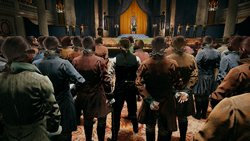
Opening reunion of the Estate General of 1789
On the 5 May 1789, the deputies of the different Estates assembled at the Hôtel des Menus-Plaisirs in Versailles to open the Estates-General with a speech from the King. During the speech, the noble deputy and Grand Master François de la Serre secretly met the deputy of the Third Estate and Mentor of the Parisian Brotherhood of Assassins Honoré Mirabeau. Together, they spoke about the future of France and decided to make a truced between their factions. During the night, François de la Serre organised a ball at the Palace of Versailles for the induction of his daughter, Élise de la Serre, as a member of the Templar Order. But after the ceremony, the Grand Master was murdered by Charles Gabriel Sivert and the Roi des Thunes, two members of Germain's faction. With the death of de la Serre, a civil war between the Templars began, Germain taking the title of Grand Master for the extremist faction, and Élise taking the role of his father for the old guard.[1]
During the meeting, the primary problem was the voting process: a vote by order, which favorised the nobles and clergymen, or by head, which favorised the Third-Estate. The highly public debate over its voting process had erupted into hostility between the three orders, eclipsing the original purpose of the meeting and the authority of the man who had convened it. On June 17, with talks over procedure stalled, the Third Estate, led by their president Jean Sylvain Bailly, met alone, invating members of the other two orders and formally adopted the title of National Assembly; three days later, they met in a nearby indoor tennis court and took the so-called Tennis Court Oath, vowing not to disperse until constitutional reform had been achieved. Among this deputies there were Mirabeau, Bailly, Sieyès, Joseph-Ignace Guillotin, and also Maximilien de Robespierre, a Templar from Germain's faction. On June 23, the king ordered to disolve the Assembly, but the Mentor stated that they would "yield to nothing but bayonets". Within a week, most of the clerical deputies and 47 liberal nobles had joined them, and on June 27 Louis XVI grudgingly absorbed all three orders into the new assembly.[1]
Popular revolt
On July 12, as the National Assembly continued to meet at Versailles to work on a new Constitution, fear and violence consumed the capital. Though enthusiastic about the recent breakdown of royal power, Parisians grew panicked after the news of the remplacement of the Controller-General of Finances Jacques Necker, who have sympathy with the Third Estate, by the more conservatist Joseph Foullon de Doué, and also as rumors of the arrestation of the Assembly and an impending military coup in Paris by the royal troops began to circulate. At the Palais-Royal, the journalist Camille Desmoulins called the Sans-culottes, the lower class in France, to take ups the arms. The popular insurgency also have the supports of the militaries of the French Guard, and the 13 July was created the National Guard, which have for purpose to restore order in the capital.[1]
On July 14, rioters took riffles in the Invalides but need gunpowder. So the insurgent went to the Bastille to reclame gunpowder to his governor Bernard-René de Launay. After he refused, the Sans-culottes stormed the Bastille. Among the rioters, Élise de la Serre wanted to liberate Arno Dorian, her lover who was wrongfully imprisoned for François de la Serre's murder.[2]The young man succeeded to escape from the prison with the help of Pierre Bellec, a Master Assassin who had trained Arno's father, Charles Dorian. After the storming, the prisoners where liberated and the governor de Launay was killed, beheaded and his head placed on pike. The events of this day, now commemorated in France as a national holiday, as the start of the French Revolution.[1]
After the Bastille, the King withdrew his troops and recalled Necker in his government. On July 15, The Marquis de Lafayette, the hero of the American Revolution and an ally of the Assassins, was elected as the commandant of the National Guard. Lafayette proposed to the King to adopt the tricolor Cockade, with the red and blue for Paris and the white for the French monarchy. The King accepted the 17 July. At this time in Paris, Joseph Foullon de Doué began to hoard food to sell it at a higher price. The Assassins helped the people to access to the food and the 22 July, the crowd hung de Doué to a lamp at the Place des Grèves before beheading him. With most of the officials of Paris gone, Paris Commune was created by the Sans-culottes to administrate the city and Jean Sylvain Bailly became the mayor of Paris.
The wave of revolutionary fervor and widespread hysteria quickly swept the countryside. Revolting against years of exploitation, peasants looted and burned the homes of tax collectors, landlords and the seigniorial elite. Known as the Great Fear, the agrarian insurrection hastened the growing exodus of nobles from the country and inspired the National Constituent Assembly to abolish feudalism and priviledges of Clergy on August 4 night, ending the Ancien Régime.[1]
On August 26, the Assembly, under an idea of Lafayette and Mirabeau, adopted the Declaration of the Rights of Man and of the Citizen, a statement of democratic principles grounded in the philosophical and political ideas of Enlightenment thinkers. The document proclaimed the Assembly’s commitment to replace the Ancien Régime with a system based on equal opportunity, property, freedom of speech, popular sovereignty and representative government.

Théroigne leading the Women's March on Versailles
Even with the resolution of political problems, the French population starved. On October 5, the women who worked in Paris marketplaces began to protest, leading by Théroigne de Méricourt, and began a march on Versailles to speak to the royal family. Taking arms from the Hôtel de Ville and being support by the National Guard, the protestation was infiltrated by the radical Templars, who wanted to create a violent riot against the royal family. A team of Assassins was sent to protected Méricourt and killed the Templar agents. The crowd arrived in the Palace of Versailles without harm and after audience and the breaking of the Palace, the King said to the crowd that he accepted the Constitution and that he returned to Paris.[1]
The same day, the radical Templars killed every supporter of Élise de la Serre. The heiress of de la Serre escaped by jumping in the Seine. She decided to train herself better before resuming her quest of revenge.[2]
Time of changes
After the popular revolts, the Kingdom of France experienced many changes. Politically, the royal family resided in the Tuileries Palace in Paris and the National Assembly in the Salle du Manège near the Jardins des Tuileries. The National Assembly was elected by the people and the territory was reorganised in departement. Many political club opened during the Revolution, as the Jacobins Club or the Club of Cordeliers with Georges Danton, a famous orator during the Revolution. The Bastille was dissassembled to erase the symbol of arbitraty of monarchy and used the stone for other monuments, as the Concord bridge. The freedom of press increased with a numbers of journals created, revolutionnary, as L'Ami du peuple of Jean-Paul Marat and le Père Duschesne of Jacques Hébert, or royalist as Les Actes des Apôtres, created to informe population of the events in the country and polarized their opinion. For decreasing the debt of France a new paper money was created, the assignats which was backed by the values of the properties of Church confiscated by the Nation. The Walls of the Farmers-General were destroyed and with the end of privileges, everyone payed taxes.[1]
The equality between people was searched in every fields, even in death. The Dr Guillotin militated for the equality of the death sentence, Antoine Louis and Tobias Schmidt worked on a machine which would make the death painless, it was name the Guillotine and used as the only mean for death sentence in France. The Church in France was also reformed with the requisition of land of Church and the end of monastic vows. On the 12 July 1790, the Civil Constitution of the Clergy was approved, ending the monastic orders in France and the clergymen must now juring oath to the State of France and not the Pope. The priest who refused were called "refractory priests" and the Pope didn't recognized the Constitution. A year after the storming of the Bastille was organized the Fête de la Fédération, to prove the unity of the country with the King, the National Assembly and the People. The ceremony was in fact a success.[1]

Arno meeting Germain
During this time, the Assassins tried to make the Revolution peacefull as possible, as Mirabeau was in the National Assembly and served as an advisor for the King. The Mentor wanted also to observe the truce he made with de La Serre, so the Templars profited of this to make their plans. In January 1791, with the population attacking nobles and churches, Charles Gabriel Sivert organized a smuggling network to protecte nobles and clergymen in return of their wealths. Knowing that, the Assassin Council ended the truce and Arno Dorian, who became an Assassin to redeem himself as he didn't delivered the letter which could prevent de la Serre's murder, was appointed to investigate on his foster father's assassination. After assassinating his step-father's murderers, Sivert in Notre-Dame and the Roi des Thunes in the Cour des Miracles, Arno discovered that they had a connection with Germain, but Arno believing that he was only the silversmith who created the Templar pin which killed de la Serre. Interrogated by Arno, Germain profited of his ignorance to mislead the Assassin and said that Chrétien Lafrenière was the Templar who hired him to create the pin. Arno discovered that Lafrenière prepared an attack and destroyed his stock in the Halle aux Blés and assassinated Lafrenière in the Holy Innocents' Cemetery while he was in a reunion with Templars of other rites. [1]
In fact, Lafrenière was the most loyal man of de la Serre, even preventing him of the trahison which cost his life, and the attack he prepared wasn't against the Assassins but the Hôtel de Beauvais, where radical Templars had a reunion. While the Jaccobins listened a speech of Robespierre, under the Hôtel de Beauvais Germain reunited with his advisors: Marie Lévesque, Louis-Michel le Peletier, Aloys la Touche, the lieutenant of the Roi des Thunes, and Frédéric Rouille, a captain of the National Guard. They orchestrated the next step of their plan: while Lévesque will organized a food hoarding to make the population more violent, Rouille will collected proofs that incriminate the King as a counter-revolutionary and le Peletier, as a member of the National Assembly, will assurated that this proofs served for the trial of the King. Germain also declared that he had set a trap to kill Élise de la Serre, but Arno who eavesdropped the reunion, saved Élise.[1]
Arno proposed an alliance between Élise and the Assassins to track the radical Templar but many Assassins opposed to that even if Mirabeau wanted to help the young Templar to ensured a future peace with the Templar Order. But the alliance was never conclued as Mirabeau was poisoned by Pierre Bellec and tried to incriminated Élise for the murder. Bellec also tried to poison all the Assassins to reform the Brotherhood as army and not a political force but Arno killed him in the Sainte-Chapelle. With the deaths of two Master of the Council, the Assassins refused the alliance with Élise and Arno was dismissed on the investigation of de la Serre's murder. Mirabeau was cremated and the National Assembly buried him in the Panthéon as a hero of the Revolution.[1]
Fall of Monarchy
With the death of Mirabeau, the King lost his most powerful supporter in the National Assembly. Feeling more as a prisoner than a king in Paris, the 20 June 1791, Louis XVI flew with his family to Varenne but they were recognized and brang back to Paris. This event dicreased the popularity of the King and some as Danton and Robespierre reclaimed the deposition of Louis and the proclamation of a French Republic. The Jacobins who wanted the King to stay formed the Feuillants Club. The things get worse when the 17 July, a crowd reunited on the Champ de Mars to sign a petition for the removal the King were shot by the National Guard led by Lafayette. In August in the French colony of Saint-Domingue, a revolution of slaves was led by the Saint-Dominigue Brotherhood of Assassins. Even if the revolted wanted liberty, they were loyal to the King of France.[3] On September the Constittion was adopted, France was the a constitutional monarchy, the King could choose his government and had a veto against laws.[1]
But the threat of war against the Habsburg dynasty, the family of the Queen Marie-Antoinette, increased at the end of the year 1791, as the brother of the Queen had sympathy for the counter-revolutionnaries and wanted to retablish the autority of his brother-in-law. The Girondists, deputies of the Legislative Assembly led by Jacques Pierre Brissot, wanted to declare war against the Austria, hoping to spread the revolutionary ideals across Europe through warfare. On the other hand, the Montagnards, led by Robespierre, wanted to keep the peace to consolidate the Revolution in France. Otherwise, in April 1792, the Legislative Assembly declared war on Austria and the French Army invaded the Austrian Netherlands, beginning the French Revolutionary Wars. Prussia joined Austria in the war.[1]
In Paris, the population began to starve as Marie Lévesque and Flavigny hoarded food during the summer 1792 to anger the crowd. Théroigne de Méricourt investigated on that case and helped by the Assassins recovered the food before the Assassins killed Flavigny.[1]
With numbers defeats on the front, the Assembly proclamed a military conscription and many troops arrived in Paris. With the news of an alliance between the King of France and the counter-revolutionnaries army and the upkeep of the King, a part of the Sans-culottes, influenced by the Jacobin Club who was controled by the Templars, revolted and took power in the Hôtel de Ville on the 9 August 1792 and organized them as the Commune. The next day, the Commune was supported by the the National Guard and attacked the Tuileries Palace. In the angry mob, Frédéric Rouille led a group of Templars to enter in the palace to recover proofs of the King's treason against the Nation.[1]

The Tuileries under attack
The Assassins Council, which discovered that Mirabeau had sent letters to the King with important informations on the Brotherhood in France, sent Arno Dorian to infiltrate the palace and destroyed the letters before the Templars recovered its. In the King's office, the Assassin met a young soldier, Napoleon Bonaparte, who searched a key to open a temple of the First Civilization under the Basilica of Saint-Denis.[4] The two allied and took what they searched before fleing when Rouille and his men arrived. The Templars recovered the proofs they need for the trial of the King. During the attacked the royal family flee the palace protected by the Swiss guards and arrived in the Salle du Manège to be protected by the Legislative Assembly. But when the rioters arrived, the King was arrested and prisoned in the Temple. The Legislative Assembly was replaced by the National Convention with a strong influence of the Commune. With the violence of 10 August a new wave of émigrés fleed the country, as Lafayette who was accused as a traitor.[1]
The following month, a wave of violence occured in Paris and France's prisons with the preventive executions by the Sans-culottes of accused counter-revolutionaries, to prevent a royalist uprising. Many of the prisoners were common criminals or non-juring priest. Rouille and his men led an attack on the Grand Châtelet and began to kill the prisoners. Arno, who tracked Rouille since the 10 August, infiltrated the prison and assassinated the captain without the permission of the Council. The 2 September, a Austrian spy ring tried to deliver informations on Paris' defense and to kill Georges Danton, who delivered a speech which restored hope and will in the revolutionnaries. A team of Assassins saved Danton, who became an ally of the Brotherhood, and killed the Austrian spies. On 20 September, the French army defeated the Austrian army at Valmy. With this victory, the next day the National Convention proclaimed the abolition of the monarchy and the establishment of the French republic, the universal suffrage were instored, the Convention was in his majority Girondist after the first election.[1]
During the month of October, the Templar Marie Lévesque continued to hoard the food arriving in Paris. Her plan was to accuse the royal family of hoarding the food to starve the people. She organized a party in the Luxembourg Palace, which serve also as a prison at this time but also as the location where the food was stocked, and intended that the guests discovered the food. But her plan failed as Élise de la Serre moved the food and Arno Dorian killed her during the party.[1]
On December 11, after the discover of documents in the Tuileries Palace incriminating the former King in an alliance with the Austrian monarchy to end the Revolution, the Convention opened a trial against Louis Capet. Judging him for treason against the Revolution and the Nation, the deputies recognized him guilty the 15 January 1793. The next day, the Convention voted the sentence of Louis Capet. With 360 votes for execution and 360 votes for clemency, the Templar Louis-Michel le Peletier made the 361st vote for execution. After the trial, le Peletier informed Germain of the result and promised he could see the execution. On 20 January, le Peletier assisted to a party in the Palais-Égalité and was assassinated by Arno who need information on Germain's location. Le Peletier was seen as a martyr of the Revolution.[1]
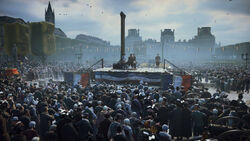
Execution of Louis XVI
The next morning at the Place de la Révolution, the public Execution of Louis XVI began. A scaffold was builted with a guillotine and the executioner Charles-Henri Sanson oversaw the execution of Louis. The crowd amassed to see the death of the former King. Germain, who saw the event from a tribune, was confronted by Arno. Explaining to the Assassin as that the population didn't fear anymore the power of nobility and Church, the Templars could control the population with gold. When Louis was guillotined, Germain declared the de Molay was avenged and flee the place before Arno could kill him. As Élise de la Serre came to save Arno from Germain's henchmen, Arno decided to protect her instead of following Germain. This decision infuriated Élise and she decided to end their partnership as Arno couldn't sacrifice her life to avenge her father's death. After this Arno was summoned by the Assassin Council who discovered that Arno resumed his hunt for Germain without their permission. As it was the third time he disobeyed to the Council, Arno was expelled from the Brotherhood.[1]
Reign of Terror
Following the king’s execution, Spain and Portugal joined Austria in the war against the France and the Convention declared war to United Kingdom and Dutch Republic. On March in Vendée, a military royalist uprising known as the Chouan revolted against the conscription and the anti-clerical direction of the Revolution. The same month was created the Revolutionnary Tribunal to arrest ennemy of the Revolution and in April the Committee of Public Safety became the executive government of the Republic.[1]
The divisions increase between the Montagnards, who wanted exceptional measures to stop the violence and a centralize power France with Paris, and the Girondists, who were more moderate and wanted a federal government. The Girondists who had the majority in the Convention tried to arrest Marat, but he was liberated. As revenge, Marat used his Journal to demand the arrestation of the Girondists. The 2 June, François Hanriot, the Commander General of the National Guard in Paris and a Templar puppet, led the Sans-culottes with cannons to the Convention and arrested Girondist deputies. Danton, tried to stop this but wasn't listen by Robespierre, who organised the arrestation. A team of Assassins rescued the deputies who were not arrested and smuggled them out of Paris. After the arrestation of the Girondists, a federalist uprising began in the South of France, like in the city of Lyon and Marseille, and in Normandy to fight the centralization of power in Paris.[1]
With the fall of the Girondists, the Montagnards seized control of the Convention but oppositions with the Sans-culottes as Jacques Roux and his Enragés who demanded social reforms and more radical measures against the ennemy of the Revolution. On 13 July, Marat was assassinated by Charlotte Corday, a sympathizer of the Girondists who killed him for his role in the arrestation of Girondists. She was arrested by Arno Dorian and guillotined the 17 July. Ironically, she wanted to save people from the guillotine, her actions increased the paranoia of ennemies of the Revolution, instituting a series of radical measures.[1]
During the month of July, the General Marcourt, a member of Templar Order, prepared a military coup against the Convention to accelerate the Revolution. With other Templars, he wanted to recruit skillful men during a tournament in Paris. The General Thomas-Alexandre Dumas, who was contact by Marcourt for his plan, was in fact a ally of the Brotherhood and asked the Assassins to infiltrate the tournament which they won to approach Marcourt, killing him and his followers in the Hôtel des Invalides.[1]
In August, the Convention further the dechristianization of France with the order to destroy the royal necropole in Saint-Denis. Dom Poirier and Alexandre Lenoir witnessed the destruction of royal artefacts and religious symbols, they tried to save most of them. After that, Saint-Denis was renamed Franciade and the Convention established the Revolutionary calendar to replace the Gregorian calendar and the Cult of Reason was choose as a State religion.[4]
With Robespierre and Louis Antoine de Saint-Just in the Committee of Public Safety, the Templars went a step foward in their plan to control France with the unleashing of the Reign of Terror. Germain wanted that the people feared absolute liberty, so during this period, suspected enemies of the revolution were guillotined in public, to show the danger of freedom and they need to obey. In September, the Law of Suspects passed, any suspected counter-revolutionary were arrested and judged. Important political figures were arrested end executed. In September the leader of Enragés Jacques Roux was arrested by Robespierre as he was impredictable for Templars plan. He was sent to Saint-Pélagie prison and moved later the Salpêtrière Hospital. The Templars wanted to keep Roux as a back up plan if Robespierre fell. In October, the Girondists arrested in June as Brissot were guillotined and Marie-Antoinette knew the fate of her husband the 16 October. In November, the feminist authors and girondist supporters Marie-Jeanne Phlippon Roland and Olympe de Gouges were executed. Philippe Égalité, cousin of Louis Capet who vote for his execution was guillotined. The former president of the National Assembly and mayor of Paris Bailly was guillotined as he refused to testify against the former Queen.[1]
The Law of Suspects could applicate on the agents of government, as Didier Paton, a patriotic spy who denounced many suspects, was arrest by Robespierre for discovering the Templar Order. The Assassins rescued him during his execution and recovered his notes on the Templar Order before inducted him in the Brotherhood. The Assassins also killed the Templar Jean Gilbert who foiled their plan to save Marie-Antoinette. At the end of year, the federalist uprising was broken after the take of Toulon where Napoleon Bonaparte illustrated his tactician's skills.[1]
In February 1794, the Convention proclaimed the abolition of Slavery in the colonies. This news changed the status quo of the Haitian Revolution, as Toussaint Louverture, a Haitian General and an Assassin, defected the Spanish Army to join the French troops.[3]
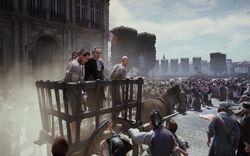
Danton and his acolytes on the way for the Guillotine
The same month, the Templars wanted to release Jacques Roux to increase the Terror in Paris. A team of Assassins went to Salpêtrière Hospital to kill Roux but they were captured. A second team rescued the first one and killed the leader of Enragés. With the destruction of the Enragés, a new radical group rose, the Exagérés, led by Jacques Hébert, who wanted to further the Terror. Danton led the Indulgents, who wanted to stop the Terror. In March, the two groups were tried and comdamned as ennemies of the Republic. Robespierre especially wanted Danton dead as him and his friends compared Robespierre as a dictator. François Hanriot found in Danton's correspondence the name of his supporters who weren't arrested. The Exagérés were executed at the end of March. On 4 April, Danton, Desmoulins, Fabre d'Églantine and other persons were sent to the Guillotine. The Assassins wanted to rescue Danton but he refused as his death will be the Fall of Robespierre and asked the Assassins to save his friends. The Assassins obeyed to his last will and succeeded in their missions.[1]
Thermidor
With the death of Danton, the popularity of Robespierre began to decrease. In May, he sent his henchmen in the Panthéon to recover the relics of Mirabeau, exposing his ties with the Assassins and compromising the Brotherhood as their former Mentor had a correspondance with the King. Two Assassins entered in the Panthéon and deplaced Mirabeau'relics.[1]

Robespierre during the Festival of the Supreme Being
The Assassins weren't the only persons who fight Robespierre. Arno Dorian and Élise de la Serre decided to resume their hunt against the radical Templars. In Versailles, Arno assassinated Aloys Latouche, who was appointed chief of the execution in the city by Robespierre. Following this track, the two lovers went to Paris and assisted on 8 June to the Festival of Supreme Being, a deist cult founded by Robespierre to remplace the atheist Cult of Reason. During this event, Élise poisoned Robespierre with ergot to make him look like a mad man during his speech while Arno gave to the rivals of the Templar lists of deputies names wrote by Robespierre, to frame him as he wanted to executed them. This returned the popular opinion against Robespierre as the former Assassin and the young Templar expected, and as his supporters dicreased the two would ask to Robespierre where was Germain.[1]
On 10 June, Robespierre increased the Terror, calling for a purge of members of government who perpetrated massacres around France. One of them, Jean-Lambert Tallien, was on a list which were found by Arno. So Tallien led a group of deputies and the Convention voted for the arrestation of Robespierre and his accolytes on the 27 July. But on the road to the prison of Luxembourg Palace, the Communes rose against the Convention and freed the arrested. A fight between the Commune and the Convention spreaded in the city. Robespierre and his men took refuge in the Hôtel de Ville. While the troops of the Convention led by Paul Barras surounding the building, Arno and Élise infiltrated the Hôtel de Ville to interrogate Robespierre. After Élise shot Robespierre in the jaw, he wrote the information that Germain was in the Temple. Then the two lovers fleed from the building while the troops of the Convention arrested Robespierre and his band.[1]
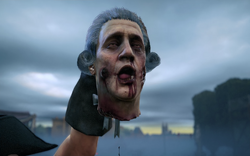
Robespierre guillotined
The next day, Arno and Élise confronted Germain in the Temple. The Grand Master was in possession of a Sword of Eden, an Isu technology hid by Jacques de Molay's advisor the night of the arrestation of the Templar Order. During the fight, the sword projected an energy blast that killed Élise and wounded Germain. Arno who saw the death of his lover, killed Germain remorseless. In his final confession, Germain explained all what he did to Arno and even if he is dead someone else would take control of the new society he created. After that, Arno left the Temple caring the corps of remorseless. In his last confession, Germain explained all what he did and that even if he is dead, someone else would take control of the new society he created. After that Arno left the Temple carring the corps of Élise and kept the unpowered Sword of Eden. On the same morning, Robespierre and his men, like Saint Just and Hanriot, where guillotined at the Place de la Révolution. Their deaths were the beginning of the Thermidorian Reaction, a phase in which the French people revolted against the Reign of Terror’s excesses. Some as the Muscadins took revenge on the Sans-culottes and killed them. The night of the 29 July, Théroigne de Méricourt led an attack of the convent of Jacobins where the last remnants of the Germain's faction took refuge. Assassins helped Théroigne and killed the jacobin leaders, ending their control on France.[1]
In the weeks that followed, the arrestations of the allies of the Jacobins continued. On August, Napoléon Bonaparte was arrested for his connection with Augustin de Robespierre, Maximilien's brother, but also for illegaly sent a troops in Franciade. In fact Bonaparte commanded the captain Philippe Rose to open the Temple under the Basilica of Saint-Denis with the key he found in the Tuileries Palace. Arno, who was in the city to recover a manuscript of Condorcet for the Marquis de Sade in exchange of a passage out of France, was convinced by the orphan Leon to thwart Bonaparte's plan. Arno entered in the Temple, killed Rose and took the Head of Saint Denis, a lantern that create illusions. In the lantern, Arno discovered an other Piece of Eden, an Apple of Eden, an artifact that can controled human minds. To prevent that Bonaparte retrieved the Apple, Arno sent it to Al Mualim, the Mentor of the Egyptian Brotherhood of Assassins in Cairo.[4] After that, Arno decided to stay in France and worked to be reintroduce in the Brotherhood and to bring closer the Assassins and the Templars as Élise wanted.[2]
End of the Revolution

Napoleon ordering to fire on the royalist insurgents
After the fall of Jacobins the Sans-culottes had no more power on the Revolution and the middle class had more rights with the liberation of the economy. While the Jacobins were arrested, the former suspects were freed, which increased the ranks of royalist movement who will oppose against the Republican. The new of the death of Louis XVI's son in his prison made that Louis XVI's brother became Louis XVIII of France and reclamed the throne for his family. On August 22, 1795, the National Convention, composed largely of Girondins who had survived the Reign of Terror, approved a new constitution that created France’s first bicameral legislature with the Council of Five Hundred and the Council of Ancients. Executive power would lie in the hands of a five-member, the Directeurs, appointed by parliament. The Convention also decided that two third of the new assembly must be former deputies to prevent the Royalists to have the majority at the election. Royalists and Jacobins protested against this law and took arms against the Convention in October, or the month of Vendémiaire. They were swiftly silenced by the army led by Barras the 13 Vendémiaire, with Napoleon Bonaparte and Joachim Murat's troops fought the insurgents with cannons and grapeshot. This event ensured their popularity as saviors of the Republic. After that the new regime known as the Directoire was set up with Barras and Sieyès as Directors.[1]
The Directory’s four years in power were riddled with financial crises, popular discontent, inefficiency and, above all, political corruption. By the late 1790s, the directors relied almost entirely on the military to maintain their authority and had ceded much of their power to the generals in the field. In 1795, France controled all the Netherlands, and Spain and Prussia declared the Peace with the French Republic. Portugal, Great Britain and Austria continued the war, the last one having supporters in Paris to help the troops in an invasion, but Arno Dorian, who reintegrated the Assassins, killed them. In 1796, thank to his previous exploits and his relation with Joséphine de Beauharnais, Barras' former mistress, Napoleon obtained the commandment of the French Army in Italy. In a year with a serie of victories against Austria, Napoleon conquered the states of northern Italy and ended the Republic of Venice. After this campaign Austria declared the peace with France and Napoleon gained influence in French politics. In 1798, Napoleon was sent to conquer Egypt and cut the trade routes to India for the Great Britain. Fighting the Mamluks and the British, the French Army was victorious in a first part of the campaign before they withdrew from Egypt. Even if it was a failure, the French scientists recovered the Rosetta Stone and Napoleon took back the Apple of Eden that Arno sent to the Egyptian Assassins four years ago.[1][4]
In France, the polical situation was hazardous, with coups and insurrections from Jacobins and Royalists. Around 1798, during the elections of the Council of Five Hundred, Templars tried to entered in the Assembly to restore the Reign of Terror. Arno killed the Templars before they could entered legally in the Palais Bourbon. On 9 November 1799, the Director Sièyes staged a coup d’état with Napoleon Bonaparte and his troops. Napoleon, thank to his men and the Apple of Eden, abolished the Directory, appointing a new constition where he was the first consul of France and declared that the Revolution was ended. The event marked the end of the French Revolution and the beginning of the Napoleonic era, in which France would come to dominate much of continental Europe.[1][5]
Legacy
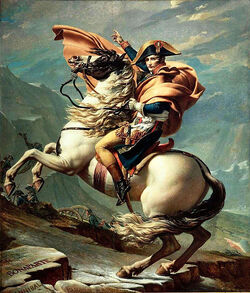
Napoleon crossing the Alps
Overall, the Revolution did see the abolishment of the Ancien Régime and the French monarchy, reducing the power of Church in France but it also established principles of inalienable rights in the Declaration of the Rights of Man and of the Citizen. The ideals of equality, liberty and self representative government of a nation developed in the world. Many revolutions occured during the next century inspired by this one, as in South America in the 1810's, Europe in the middle of 19th century, and the Russian Revolution during World War I. But this period is also remembered as a bloody era with the Reign of Terror and the wars between the French Republic and the European monarchies and later the Napoleonic Wars, creating a fear in Europe against the revolutionary ideals during the 19th century. Today, for themost part, the countries around the world are based on a regime with legislative chambers who represent their nations.
The Revolution, by the period of instabily after the death of the king, paved the way of the foundation of the French Empire by Napoleon Bonaparte,[6] who used the Apple of Eden to expand the holdings of his new empire.[5] The change of regime between monarchy, republic and empire would punctuate the political story of France during the 19th century, as the brothers of Louis XVI, Louis XVIII and Charles X of France returned on the throne after the fall of Napoleon. This constitutional monarchy lasted until July 1830, when a revolution in Paris brought Philippe Égalité's son, Louis Philippe, as king. He served as a king for eighteen years before another revolution ended the monarchy and proclamed the Second Republic inspired by the ideals of French author and Assassin Sophie Trenet. Napoleon's nephew, Louis Napoleon Bonaparte, became the first president of this Republic before proclaming himself emperor as Napoleon III. His empire fall in september 1870 after the France was defeated by the Prussian Army. A new republic was created but the Paris Commune rose again and took over the capital for two months before being broken by the republic troops. Since this event, France remained a republic all these years except during the Nazi occupation of France during World War II. Events such as the Storming of the Bastille, symbols such as the tricolor flag and the motto Liberté, Égalité, Fraternité are still celebrated in France as a part of the national identity.
Economics were also changed as the nobility and Church had no more power in France, the middle class emerged and had influence on the economic and social life in France. New technologies and scientific inventions appeared to facilitate the production, leading to the dawn of the Industrial Revolution. The Templar Order followed the ideals of Germain, leaving the titles of nobility and benifits of Church and state, and becomming industrialists and economists to rule the world from the shadow. As exemple, in the 1860's, the British Grand Master Crawford Starrick controlled the British Empire from London thank to his corporate empire, Starrick Industries.[7] In 1937, the Templar Order founded Abstergo Industries, which is still today the front-compagny of the Order operating in various fields, as pharmaceutical sector or entertainment with Abstergo Entertainment, forging the human future.[8][9]
References
- ↑ 1.00 1.01 1.02 1.03 1.04 1.05 1.06 1.07 1.08 1.09 1.10 1.11 1.12 1.13 1.14 1.15 1.16 1.17 1.18 1.19 1.20 1.21 1.22 1.23 1.24 1.25 1.26 1.27 1.28 1.29 1.30 1.31 1.32 1.33 1.34 1.35 1.36 1.37 1.38 Assassin's Creed: Unity
- ↑ 2.0 2.1 2.2 Assassin's Creed: Unity (novel)
- ↑ 3.0 3.1 Assassin's Creed: Initiates- Letters to the Dead
- ↑ 4.0 4.1 4.2 4.3 Assassin's Creed: Unity - Dead Kings
- ↑ 5.0 5.1 Assassin's Creed II
- ↑ Assassin's Creed: Initiates
- ↑ Assassin's Creed: Syndicate
- ↑ Assassin's Creed: Revelations
- ↑ Assassin's Creed IV: Black Flag
| ||||||||||||||||||||||||||||||||||||||||||||||||||||||||||||||||||||||||||||||||||||
